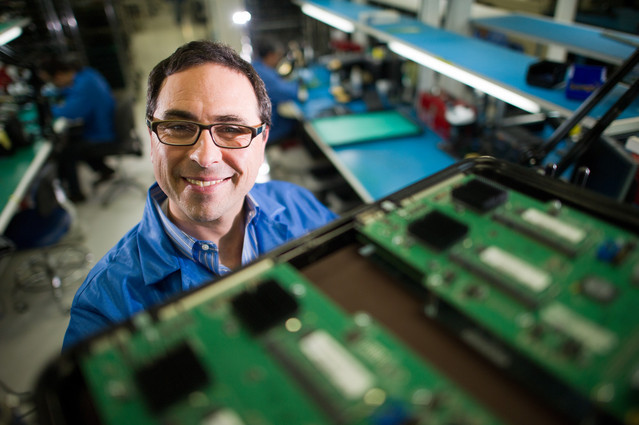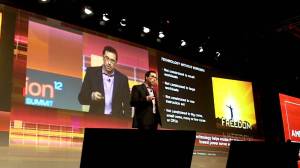VB: What does Facebook use right now?
Feldman: Their open compute rack looks very much like a rack of micro servers. It’s shared infrastructure, which was a tenet. It’s efficient processors.
VB: You’re making progress on the ARM design, then?
Feldman: We announced that we’d be sampling parts in Q1. Eight core and 16 core, 857-based. It’ll be a phenomenal part.
VB: The 64-bit ARM movement, is it—Apple just announced their first part in that space.
Feldman: How cool is that? For servers, you need 64-bit.
VB: Is the rest of the ecosystem coming along for now, as far as 64-bit ARM?
Feldman: The rest of the ecosystem is doing really well. It has a ways to go, but whether it’s OS guys like Fedora or Ubuntu or Red Hat, we’re going to have OSes. We’re going to have a Java JIT. We’re going to have everything you need, a tool chain. By the middle of next year, you’ll see amazing things.
VB: You could put micro servers in everyone’s home, I guess?
Feldman: I’m okay with that. [laughs] How do you make a micro server a consumer electronic device? Now we’re talking. That is a weird one. There are a lot of startups in storage, a lot of startups in different flavors of flash, a lot of startups in network function virtualization.
VB: Is Nebula’s mission consistent with yours as well?
Feldman: Absolutely. Nebula is doing the OpenStack appliance. These are all tributaries off the main stream. The fundamental tectonic shift is the transformation to the big data center. That means storage is different. That means software. That means virtualization. That means which CPUs you use and how you package them. All of these are part of the same notion, that these new facilities and these new customers don’t want the same shit they had 10 years ago.
I’m a big supporter of Nebula, because we believe very strongly in OpenStack. We think, among the cloud, nobody uses VMware. KVM, Xen, that’s what’s used. The OpenStack approach is first-rate. We think that, just like DataStax makes it easier to adopt Cassandra, guys like that will make it easier to adopt OpenStack.
VB: Are you waiting for something to physically play out, then? It seems like that movement started years ago, now. You’re waiting for a big milestone to happen, a trend or a crusade here.
Feldman: The reason I’ve worked at startups—You don’t work at a company called Trailing Edge Technology. [laughs] I like to be there early. There’s an unfolding. We saw a fundamental change in 2007. At Google they probably saw it in 2004. They didn’t tell anybody. They began making changes inside their business. We saw it across their entire landscape. We built a company. We changed the way servers are made. We brought to the fore the notion of workloads and matching work to compute. We brought to the fore the notion of a fabric. That’s going to play out over the next 10 years.
It’s a big wave. One of the fun parts about your job and mine is that when you see a big wave and you get out on it, it goes thundering past. You want to be riding that. Sometimes it dumps you and you drown. Other times you get the ride of your life. That’s why we do this, to see waves like that and ride them as far as they can be ridden.
VB: Do you feel that AMD is strong enough at this point to ride that wave, as you put it?
Feldman: We are. It’s an interesting question – whether, in very big waves, you’d rather be in a big boat or a small one. It’s not clear. I think we’re clearly more nimble, more agile. The fact that we don’t have fabs allows us tremendous flexibility. Intel has to pay $5, $7, $10, $12 billion a year to maintain a performance advantage. That advantage is shrinking with each fab geometry level. That’s an extraordinary strength they have, and a weakness on the flip side.
At some point, when you’re very large, your strength becomes your weakness and you get beaten quickly. In all of technology, nothing destroys capital faster than an empty fab. They cost $7 billion to make and have 1,500 or 1,700 days of life. If you have six or 10 or 12 hours a day of open fab time, you never get that back. Tens of millions of dollars a day of fab. It’s a source of advantage, and then bang! When will that be? It’s tough to say.
We like our odds. We like the flexibility we have. We like the fact that we can see a trend like ARM or micro servers and we can be in it. We don’t have politics and this lumbering-ness that you see in a company of that size. Now, there are things we wish we’d done better and things we are doing better than we’ve done in the past. There are opportunities to improve and pursue greatness. But that’s fun too. Those are the micro-adjustments you make when you’re on the big wave.
VentureBeat's mission is to be a digital town square for technical decision-makers to gain knowledge about transformative enterprise technology and transact. Learn More



